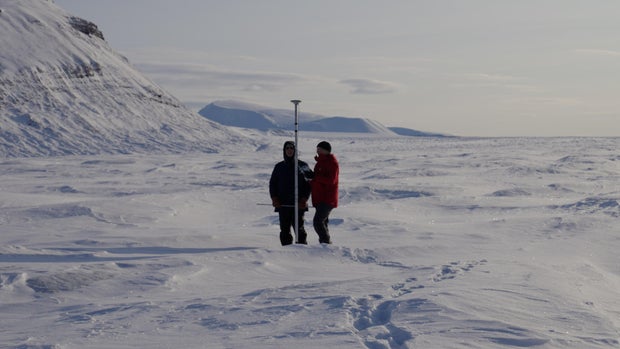[ad_1]
As mighty glaciers soften within the Arctic, new analysis finds million-year-old methane gasoline trapped beneath the ice is surfacing, with a possible to additional heat the planet.
“Glacial retreat is the large driver of gasoline escape right here,” mentioned Andy Hodson, a glaciologist on the College Centre in Svalbard, Norway.
CBS Information traveled to the world’s northernmost and fastest-warming neighborhood of Svalbard, Norway. What scientists are studying there helps Individuals perceive the modifications taking place in the US. Because the Arctic warms, it provides to rising sea ranges alongside our coasts and instability within the ambiance that contributes to our excessive climate occasions.
Throughout Svalbard, a cluster of islands near the North Pole, Hodson and his colleagues are detecting methane gasoline gurgling up by groundwater springs. As a part of their analysis, they checked 123 springs. They discovered methane in all however one.
“What’s escaping is kind of modest, however what’s down there may be fairly huge,” Hodson mentioned.
Budgeting for methane
Carbon dioxide emissions from automobiles and factories are the first driver of local weather change, and might keep within the ambiance for a whole lot of years. Whereas methane is short-lived within the ambiance, it is much better at trapping warmth.
The first sources of methane come from the manufacturing of fossil fuels and agriculture. Greater than 100 international locations, together with the U.S., have signed the World Methane Pledge, which is a dedication to chop emissions 30% by 2030.
However Hodson is worried the world’s accounting of how a lot methane is emitted every year doesn’t embrace the gasoline rising from the Arctic.
Gabrielle Kleber
“If there’s an enormous pure rush of methane about to come back, then that can change our planning for methane administration,” he mentioned. “It issues if we’ll decide to accountable methane administration,” he added.
Permafrost, a frozen blanket of soil, can lock large quantities of historical methane gasoline underground. As a glacier recedes, area can open on the fringe of the permafrost, which then permits gasoline to flee.
Disappearing glaciers
And in Svalbard, the glaciers actually are vanishing.
“It is dramatic to see the modifications from yr to yr,” mentioned Jack Kohler, an American glaciologist with the Norwegian Polar Institute, which advises the Norwegian authorities on modifications within the Arctic.
Twice a yr, Kohler visits a distant outpost referred to as Ny Alesund, house to the world’s northernmost analysis station. There, he measures a glacier referred to as Kronebreen, one of many largest of Svalbard’s 1,500 glaciers. In 30 years, he is noticed Kronebreen receding by 2.5 miles.
“We’re documenting the impact of the local weather change regionally right here,” Kohler mentioned. “I’ve colleagues everywhere in the globe who’re doing related issues they usually’re all seeing the identical factor,” he added.
On the finish of winter, Kohler kilos lengthy, steel stakes into Kronebreen’s ice to test the well being of the glacier. He begins near the glacier entrance and works his means as much as the place it begins.
CBS Information
In summer time, after the nice and cozy air temperature melts the ice, he comes again to test the stakes. This September, the primary stake he examined, which was beforehand hammered beneath the ice, was now uncovered and confirmed 8 toes of soften.
“All glaciers lose their ice by some means,” he mentioned. “And so long as the loss is the same as what is going on in on the prime, then the geometry of the glacier will stay unchanged.”
However that is not taking place. Not solely is Kronebreen retreating on the entrance, however Kohler’s measurements additionally present the glacier will not be increase sufficient new ice miles additional up, the place it begins.
Kohler mentioned hotter summers in Svalbard imply the glaciers at the moment are melting quicker than they are often replenished in winter.
“The issue is when there’s much less winter precipitation up there, after which that enormous quantity of melting, signifies that there’s an total loss,” Kohler mentioned, standing near the face of the glacier.
Kohler and his colleagues modeled future melting situations for Svalbard’s glaciers. General, they concluded by 2100, the glaciers will probably be shedding their ice twice as quick as they’re now.
Take an journey to Svalbard, Norway on this particular interactive net web page and find out how local weather change is impacting communities throughout our nation too.
Meet our consultants
Jack Kohler is a glaciologist who has studied the disappearing glaciers of Svalbard for 27 years for the Norwegian Polar Institute. It is exhausting work. On the finish of winter, Kohler lands on a glacier by helicopter to pound lengthy stakes deep into the ice. Six months later, after the summer time melting season, he returns to file how a lot of the stakes at the moment are uncovered. The extra of a stake he can see, the extra ice has been misplaced.
Andy Hodson is a methane hunter. As a professor of glaciology, he is documenting how historical methane, trapped deep underground, is escaping on the fringe of glaciers as they retreat. Hodson and his colleagues on the College Centre in Svalbard have measured 123 springs round Svalbard and located methane in all however one. Methane is a potent greenhouse gasoline that 150 international locations, together with the US, have pledged to chop. Hodson’s involved the methane he is discovering will complicate that effort.




